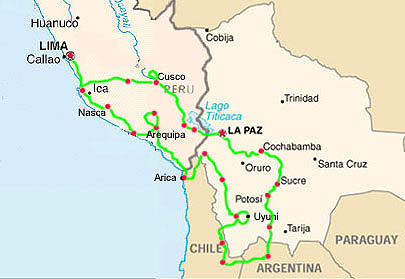
 |
|---|
| ihana.com - adventure tours - tours - altiplano |
|
altiplano |
|---|
| altiplano - highlights - dates - price - itinerary - information - booking |
| The Altiplano is the name given to the high altitude plains and deserts of Peru and Bolivia where the average altitude is over 3500m. Sparse vegetation, steaming volcanoes and smooth salt flats of this unique landscape make ideal 4x4 driving territory. |
|
Now you can enjoy the Altiplano to the full in YOUR OWN 4x4 with our stunning tour.
|
|
|||||||||||||||||||||||||||||||||||||||||||||||||||||
Highlights of the trip will be
|
 |
||||||||||||||||||||||||||||||||||||||||||||||||||||
This tour isn't a race or a rally, we positively encourage you to stop and admire the scenery and take photos whenever you like. The longest days driving won't be more than 500km and that will be an exception rather than a rule. We will have plenty of time to enjoy the landscape, leave the cars behind and take in the scenery at places like Machu Picchu. Many nights will be spent in good hotels, however, camping will be a welcome necessity in places where there is no accommodation. |
|||||||||||||||||||||||||||||||||||||||||||||||||||||
|
|||||||||||||||||||||||||||||||||||||||||||||||||||||
flights, fuel and personal insurances are all not included |
|||||||||||||||||||||||||||||||||||||||||||||||||||||
Dates Places Prices |
|||||||||||||||||||||||||||||||||||||||||||||||||||||
| The basic itinerary will be | |||||||||||||||||||||||||||||||||||||||||||||||||||||
|
|||||||||||||||||||||||||||||||||||||||||||||||||||||
please note that the itinerary is subject to change (for the better) and a fully detailed version will be made available three months before the tour starts |
|||||||||||||||||||||||||||||||||||||||||||||||||||||
|
How experienced and fit do I have to be? You will need to be a fairly competent driver and comfortable with using your vehicles 4x4 system. How do we navigate and communicate during the tour? Prior to the tour we will provide top quality maps with the route marked on together with all GPS way points. What are the roads like? The roads will vary from smooth tarmac through to gravel to very rough tracks. A significant part of the tour will
be on simple dirt tracks, often with large potholes. There will be occasional river crossings too but nothing that will damage your vehicle. Will my vehicle need special preparation? Any tough 4x4 with low and high range gears and good ground clearance is suitable. Its a good idea to have it fully serviced before shipping it, ensuring that important items such as brake pads and suspension are all in top condition. How do my car and I get to Lima and back? The price of the tour includes the containerised shipping of your vehicle to Lima and back. You will need a 'Carnet de passages et Douanes' which is available from the RAC or your national motoring organisation. Flights aren't included. We can assist but with the availability of cheap deals on the internet that would
be the best place to start. KLM, Iberia and Delta are the main carriers for Lima. What's the accommodation like? You will be staying at decent hotels of 3 star or higher standard where available. We will also be camping fairly often but the scenery will be incredible and it will be well worthwhile. What insurance cover do I need? You will be responsible for arranging your own personal health insurance.
You need to bring:-
This adventure tour is aimed at 4x4 enthusiasts who dream of really using their vehicle to its full capabilities and, at the same time, seeing the best that mother nature has to offer. You will respect nature and 'tread lightly'. We welcome people of all ages, from all walks of life and all nationalities. An open mind and a willingness to experience other cultures and to get along with your fellow travellers is essential. People interested in photography will be able to get a lot from this trip. What clothing shall I bring? As with all high altitude locations, nights are cold and you'll need a 4 season sleeping bag. During the day you could be comfortable in a T-shirt but normally a jumper of fleece will be better. A hat is essential for keeping the sun off. Vehicle:- Camping:-
|
|||||||||||||||||||||||||||||||||||||||||||||||||||||
all content is copyright © ihana.com 2001-2005